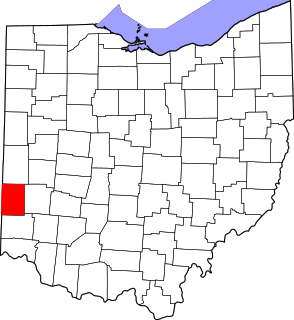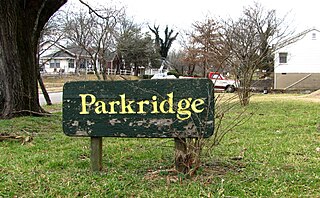
German Township is one of the fourteen townships of Auglaize County, Ohio, United States. The 2010 census found 3,748 people in the township, 770 of whom lived in the unincorporated portions of the township.

George Franklin Barber was an American architect known for the house designs he marketed worldwide through mail-order catalogs. Barber was one of the most successful residential architects of the late Victorian period in the United States, and his plans were used for houses in all 50 U.S. states, and in nations as far away as Japan and the Philippines. Over four dozen Barber houses are individually listed on the National Register of Historic Places, and several dozen more are listed as part of historic districts.

Watertown is an unincorporated community in southwestern Watertown Township, Washington County, Ohio, United States. Although it is unincorporated, it has a post office, with the ZIP code of 45787. It lies near the intersection of State Routes 339 and 676 near Wolf Creek, which meets the Muskingum River at Waterford to the north.

Coal Run is an unincorporated community in northeastern Waterford Township, Washington County, Ohio, United States. Although it is unincorporated, it has a post office, with the ZIP code of 45721. It is located along State Route 60 between the villages of Beverly and Lowell. The Muskingum River flows past the community.

The Peters House is a historic home located at 1319 Grainger Avenue in Knoxville, Tennessee. It is on the National Register of Historic Places. It is also known as White Columns or Columned Portals, as well as the George W. Peters House.

The Isaac Ziegler House was a historic home once located at 712 North 4th Avenue in Knoxville, Tennessee. Designed by prominent Knoxville catalog architect George Franklin Barber, it was listed on the National Register of Historic Places, and described as the most ornate Queen Anne-Romanesque house in Tennessee.

This is a list of the National Register of Historic Places listings in Ross County, Ohio.

This is a list of the National Register of Historic Places listings in Auglaize County, Ohio.

This is a list of the National Register of Historic Places listings in Adams County, Ohio.

This is a list of the National Register of Historic Places listings in Preble County, Ohio.

St. Anthony's Catholic Church is a historic Roman Catholic church in Padua, an unincorporated community in Washington Township, Mercer County, Ohio, United States. Built in the late nineteenth century, it remains the home of a functioning congregation, and it has been recognized as a historically significant building because of its architecture.

St. Sebastian's Catholic Church is a historic Roman Catholic church in Marion Township, Mercer County, Ohio, United States. Located in the unincorporated community of Sebastian, it is the home of an active congregation and has been declared a historic site because of its well-preserved early twentieth-century Gothic Revival architecture.

The Adolph Boesel House was a historic house in New Bremen, Ohio, United States. Built in 1898 in a combination of the Stick-Eastlake and Queen Anne styles of architecture, it was the home of a leading New Bremen citizen.

Parkridge is a neighborhood in Knoxville, Tennessee, United States, located off Magnolia Avenue east of the city's downtown area. Developed as a streetcar suburb for Knoxville's professional class in the 1890s, the neighborhood was incorporated as the separate city of Park City in 1907, and annexed by Knoxville in 1917. In the early 1900s, the neighborhood provided housing for workers at the nearby Standard Knitting Mills factory.

The Sawyer–Curtis House is a historic residence in the community of Little Hocking in Washington County, Ohio, United States. Located along the Ohio River in southern Belpre Township below the city of Belpre, Little Hocking was settled shortly before 1800. The earliest settler in the vicinity of Little Hocking was Nathaniel Sawyer, a native of Massachusetts who erected a New England-style of house there in 1798. Now known as the Sawyer–Curtis House, it is believed to have been the first permanent structure to be erected anywhere in Belpre Township. Sawyer's house is a weatherboarded structure with a tin roof and a foundation of sandstone. Built around a frame of logs, it is constructed with a typical New England floor plan, with its most significant individual feature being a massive chimney at the center of the house.

The Colonel Joseph Barker House is a historic residence in Washington County, Ohio, United States. Located north of Marietta, in the Muskingum Township community of Devola, it has changed little since its construction in the early nineteenth century, and it has been designated a historic site.

BarberMcMurry, formerly Barber & McMurry, is an architecture firm based in Knoxville, Tennessee, USA. Founded in 1915 by Charles Irving Barber (1887–1962) and Benjamin Franklin McMurry, Sr. (1885–1969), the firm designed dozens of notable houses, churches, schools, and public facilities in Knoxville and the surrounding region in the early 20th century, several of which have been listed on the National Register of Historic Places. In recent decades, the firm has expanded its focus to include larger-scale projects, such as hospitals, stadiums and retail complexes.

The William Gedamke House is a historic residence in Gresham, Oregon, United States. Prominently located near Gresham's original business core, it is one of the finest expressions of the Queen Anne style in the city. It was constructed circa 1900, about the time the first interurban trains reached Gresham from Portland. The design was based on a widely circulated 1891 mail-order plan book by George F. Barber.





















